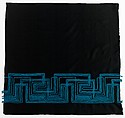Textile
Textile design attributed to Sarah Lipska Polish
Not on view
This object is from a collection of sample embroideries, which was originally owned by Morris de Camp Crawford, editor of Women's Wear Daily, who collected objects which told the story of fashion and fabric history. Included in this collection was a group of textiles which illustrated what American and French designers and manufacturers were using. According to Crawford's book The Ways of Fashion, the work of Polish artist Sarah Lipska (1882-1973) was represented in this collection. Lipska is an enigmatic figure, who is known to have worked with Leon Bakst as a set and costume designer for the Ballets Russes, and later in the 1920s as a fashion designer in Paris at 4 rue Belloni, and finally as a sculptor. Extant examples of her work are rare. Although only a few pieces in the Brooklyn Museum collection bear a label or a signature, others bear hallmarks of her work, such as a distinctive form of whip stitching on appliqué work, unusual abstract motifs, and Cubist-inspired patterns.
This brilliant design, showcasing an intricate hand-applied design of teal blue binding, exhibits an artistic sense of depth. The way the binding is crossed over itself creates a sense of background and foreground, and a level of dimension and texture. To apply the binding by hand would be a time-consuming process, and would require a high level of skill. It also shows the quality of objects Crawford was interested in collecting.
Due to rights restrictions, this image cannot be enlarged, viewed at full screen, or downloaded.

